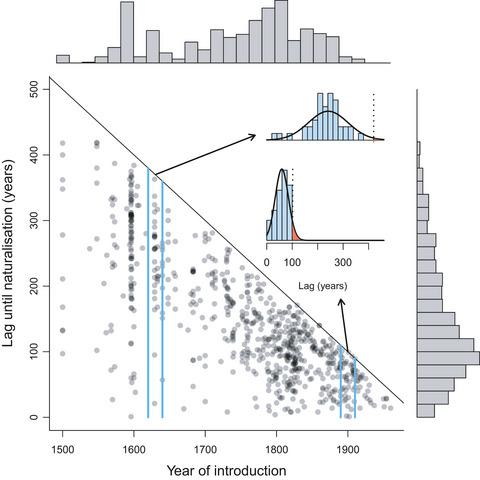当前位置:
X-MOL 学术
›
Ecol. Lett.
›
论文详情
Our official English website, www.x-mol.net, welcomes your feedback! (Note: you will need to create a separate account there.)
Time lags and the invasion debt in plant naturalisations
Ecology Letters ( IF 8.8 ) Pub Date : 2021-04-25 , DOI: 10.1111/ele.13751 Richard P. Duncan 1
Ecology Letters ( IF 8.8 ) Pub Date : 2021-04-25 , DOI: 10.1111/ele.13751 Richard P. Duncan 1
Affiliation

|
Ecological processes often exhibit time lags. For plant invasions, lags of decades to centuries between species’ introduction and establishment in the wild (naturalisation) are common, leading to the idea of an invasion debt: accelerating rates of introduction result in an expanding pool of introduced species that will naturalise in the future. Here, I show how a concept from survival analysis, the hazard function, provides an intuitive way to understand and forecast time lags. For plant naturalisation, theoretical arguments predict that lags between introduction and naturalisation will have a unimodal distribution, and that increasing horticultural activity will cause the mean and variance of lag times to decline over time. These predictions were supported by data on introduction and naturalisation dates for plant species introduced to Britain. While increasing trade and horticultural activity can generate an invasion debt by accelerating introductions, the same processes could lower that debt by reducing lag times.
中文翻译:

植物归化中的时间滞后和入侵债务
生态过程通常表现出时间滞后。对于植物入侵,物种在野外引入和建立(归化)之间的几十年到几个世纪的滞后是很常见的,这导致了入侵债务的想法:引入的速度加快导致引入物种的不断扩大,这些物种将在自然环境中归化。未来。在这里,我展示了生存分析中的一个概念,即风险函数,如何提供一种直观的方式来理解和预测时间滞后。对于植物归化,理论论证预测引入和归化之间的滞后将具有单峰分布,并且园艺活动的增加将导致滞后时间的均值和方差随着时间的推移而下降。这些预测得到了引入英国的植物物种的引入和归化日期数据的支持。
更新日期:2021-06-13
中文翻译:

植物归化中的时间滞后和入侵债务
生态过程通常表现出时间滞后。对于植物入侵,物种在野外引入和建立(归化)之间的几十年到几个世纪的滞后是很常见的,这导致了入侵债务的想法:引入的速度加快导致引入物种的不断扩大,这些物种将在自然环境中归化。未来。在这里,我展示了生存分析中的一个概念,即风险函数,如何提供一种直观的方式来理解和预测时间滞后。对于植物归化,理论论证预测引入和归化之间的滞后将具有单峰分布,并且园艺活动的增加将导致滞后时间的均值和方差随着时间的推移而下降。这些预测得到了引入英国的植物物种的引入和归化日期数据的支持。



























 京公网安备 11010802027423号
京公网安备 11010802027423号